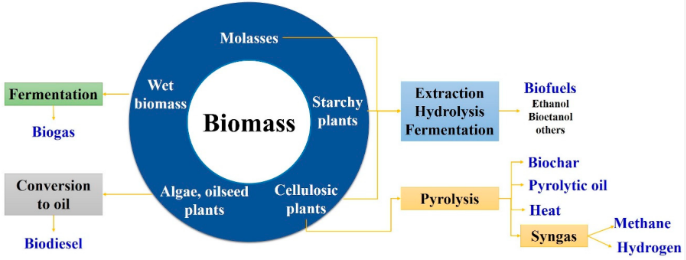A biofuel is a renewable energy source derived from organic materials or byproducts of their processing and conversion. These organic materials, commonly referred to as biomass, can be directly converted into liquid fuels known as “biofuels,” which can be used as a transportation fuel. Transportation fuels are classified as either fossil fuels (primarily crude oil and natural gas) or biofuels (made of renewable resources). The transportation industry is based on liquid fuels. Liquid fuels have the advantage of being simple to store. Gaseous fuels are used less frequently in transportation, and solid fuels have even fewer applications. Currently, the most common biofuels are ethanol and biodiesel.
What to know about Biofuels

Types of Biofuels from Biomass
Biofuels are derived from biomass, and it is generally believed that their combustion is CO2 neutral. The amount of CO2 that was drawn from the atmosphere during photosynthesis and plant growth is roughly equal to what is released after burning. The carbon cycle is completed as a result. Most exhaust streams from combustion engines contain non-toxic substances such as nitrogen, carbon dioxide, and water.
The potential of available feedstock sources is critical for biofuels, and the overall biofuel potential is heavily influenced by climate. Climate, Available land for cultivation, and the productivity of dedicated energy crops all significantly impact total biofuel potential. Concerns about global climate change, primarily caused by fossil fuel use, are one of the significant drivers of biofuel development worldwide.
Scientific evidence is that accelerating global warming contributes to greenhouse gas emissions (GHG). Carbon dioxide is a crucial contributor to greenhouse gas emissions (CO2). However, Greenhouse gases include nitrous oxide (N2O), methane (CH4), and several other compounds, which are even more severe than CO2 in terms of global warming. Due to their potential for causing global warming, it has become common practice to weigh their emissions and aggregate them to CO2 equivalents.
On the other hand, greenhouse gases that are directly toxic to human health are also emitted. Particulate matter (PM), volatile organic compounds (VOCs) (including hydrocarbons HC), nitrogen oxides (NOx), carbon monoxide (CO), and a variety of unregulated toxic air pollutants are among the primary transport emissions from the combustion of both fossil and renewable fuels. The type of feedstock is the overall critical point of how biomass production influences climate. It determines the amount of carbon concealed in the soil and the energy yield per unit of land. It is also necessary to consider what crops these crops are replacing. GHG emissions are expected to rise if they replace natural grasslands or forests. But if energy crops are cultivated on barren or dry terrain, traditional crops cannot thrive. In that situation, they can reduce considerably lower related emissions.


No comments yet